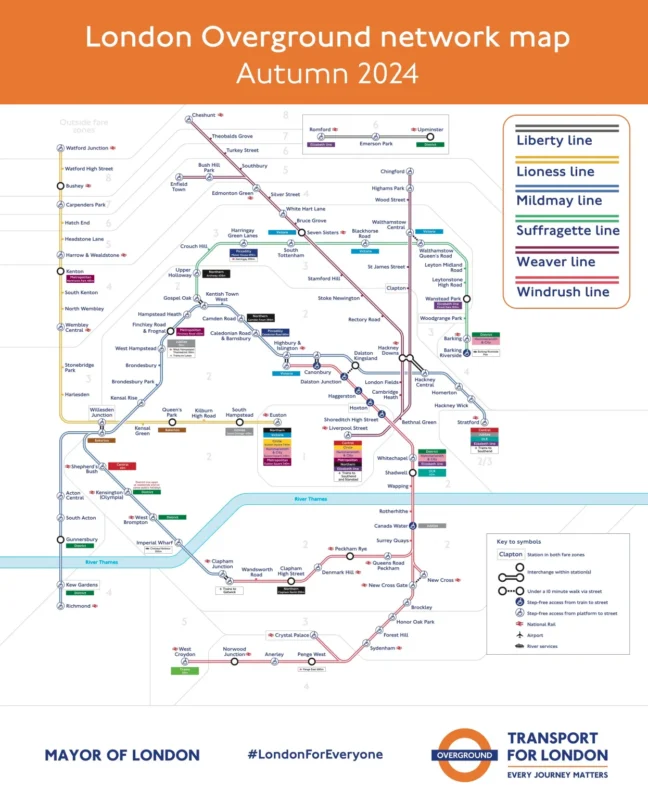The London Overground, whilst useful as a transport connection around the capital, can be confusing for some people, given the orange spiral of sometimes non-interconnected lines.
Thus, it’s time for a big rebrand, with the six lines of the Overground getting new names (akin to how all the London Underground lines have names).

The new London Overground – Image, Transport for London.
The new line names are:
- The Lioness line: Euston to Watford Junction. The Lioness line (what was known in the past as the Watford DC Lines), which runs through Wembley, honours the historic achievements and lasting legacy created by the England women’s football team that continues to inspire and empower the next generation of women and girls in sport. It will be yellow parallel lines on the map.
- The Mildmay line: Stratford to Richmond/Clapham Junction. The Mildmay line, which runs through Dalston, honours the small charitable hospital in Shoreditch that has cared for Londoners over many years, notably its pivotal role in the HIV/AIDS crisis in the 1980s, which made it the valued and respected place it is for the LGBTQ+ community today. It will be blue parallel lines on the map.
- The Windrush line: Highbury & Islington to Clapham Junction/New Cross/Crystal Palace/West Croydon. The Windrush line runs through areas with strong ties to Caribbean communities today, such as Dalston Junction, Peckham Rye and West Croydon and honours the Windrush generation who continue to shape and enrich London’s cultural and social identity today. It will be red parallel lines on the map.
- The Weaver line: Liverpool Street to Cheshunt/Enfield Town/Chingford. The Weaver line runs through Liverpool Street, Spitalfields, Bethnal Green and Hackney – areas of London known for their textile trade, shaped over the centuries by diverse migrant communities and individuals. It will be maroon parallel lines on the map. In the past, these were the Lea Valley Lines
- The Suffragette line: Gospel Oak to Barking Riverside. The Suffragette line celebrates how the working-class movement in the East End, fought for votes for woman and paved the way for women’s rights. The line runs to Barking, home of the longest surviving Suffragette Annie Huggett, who died at 103. It will be green parallel lines on the map. Some may know the line better as the GOBLIN – the Gospel Oak to Barking Line
- The Liberty line: Romford to Upminster. The Liberty line celebrates the freedom that is a defining feature of London and references the historical independence of the people of Havering, through which it runs. It will be grey parallel lines on the map.
The Orange Roundal uniting the services will remain, with mapping solutions including the TfL Map, , on train line diagrams, at stations and on digital journey planning tools, such as TfL Go adjusted with the new coloured lines.
The aim is to help TfL’s passengers navigate London’s transport network while also celebrating the city’s diverse culture and history. Tfl has a deep dive into the naming at https://tfl.gov.uk/naming-overground.
In Quotes
The Mayor of London, Sadiq Khan said:
“This is a hugely exciting moment, transforming how we think about London’s transport network.
“Giving each of the Overground lines distinct colours and identities will make it simpler and easier for passengers to get around. In re-imagining London’s tube map, we are also honouring and celebrating different parts of London’s unique local history and culture.
“The new names and colours have been chosen through engagement with passengers, historians and local communities, reflecting the heritage and diversity of our amazing city.”
Andy Lord, London’s Transport Commissioner, said:
“The London Overground is one of the most successful railways in the country and has grown to carry more than three million customers a week. The network, which has grown quite considerably since 2007, is currently shown as a complicated network of orange on route maps. This can be confusing for customers less familiar with the network and could be a barrier for some wanting to use the London Overground. These new names and line colours will simplify the maps and routes for our customers, and it is hoped it will encourage more people to make the most of our services. It is also a great way to tell the stories of some important parts of London’s cultural diversity.”
Forward from four lines
London Overground isn’t a new network per-say, rather was a collection of under-utilised surbuan lines. TfL took over management of these lines in 2007, adding to the network as opportunities arose.
This grew from the North of London and Watford DC lines into the East London Line and services south of the Thames, as well as routes out of Liverpool Street and the Upminster to Romford Branch, with new trains and electrification being some things that were delivered as part of the upgrade.
However, the Overground turned into an orange mess on the Underground map. This move will separate them on the map and hopefully improve the legibility of the map. Whilst Harry Beck’s design is in some respects timeless, it has suffered with new modes of transport appearing on it, as well as sponsorship items, reducing the legibility of it.
With the new colours, it should make it a little easier to find where you need to go.
Welcome to Economy Class and Beyond. Your no-nonsense guide to network news, honest reviews, in-depth coverage, unique research, as well as the humour and madness I only know how to deliver.
Our Social Media pool has expanded. You can find us across most networks as @economybeyond on Twitter, Mastodon, BlueSky, Threads and Instagram!
Also, remember that we are part of the BoardingArea community, bringing you the latest frequent flyer news from around the world.